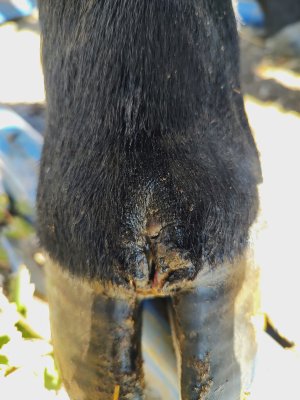Had a steer limping last week on his right hind foot and I could see swelling, debris from between his toes smelled like foot rot. They're out to pasture now and it's almost impossible to get them in at the barn or corral, so hand fed him Sustain calf boluses, which usually shows significant improvement within a day or two. Except he didn't.
Finally got him to the barn last night, right before dark (after I had to get a little Rambo through the woods as I was pushing him). On closer inspection, it looked like he split his toes, possibly on the rocks. But then I started digging around and I could actually hear a "clink" when my screwdriver hit this rock. Bless his heart, it's small but the edges are super sharp, and it was wedged waaaay up between the toes and impacted on one side. Quality time digging it out and flushing the wound, but he was a trooper - probably hurt so good, finally getting it out.
First pic was before I started working on him. You can see the horizontal gap where the rock was impacted. 2nd pic was the culprit. Didn't get a bloody, nasty "after surgery" pic.


Finally got him to the barn last night, right before dark (after I had to get a little Rambo through the woods as I was pushing him). On closer inspection, it looked like he split his toes, possibly on the rocks. But then I started digging around and I could actually hear a "clink" when my screwdriver hit this rock. Bless his heart, it's small but the edges are super sharp, and it was wedged waaaay up between the toes and impacted on one side. Quality time digging it out and flushing the wound, but he was a trooper - probably hurt so good, finally getting it out.
First pic was before I started working on him. You can see the horizontal gap where the rock was impacted. 2nd pic was the culprit. Didn't get a bloody, nasty "after surgery" pic.


